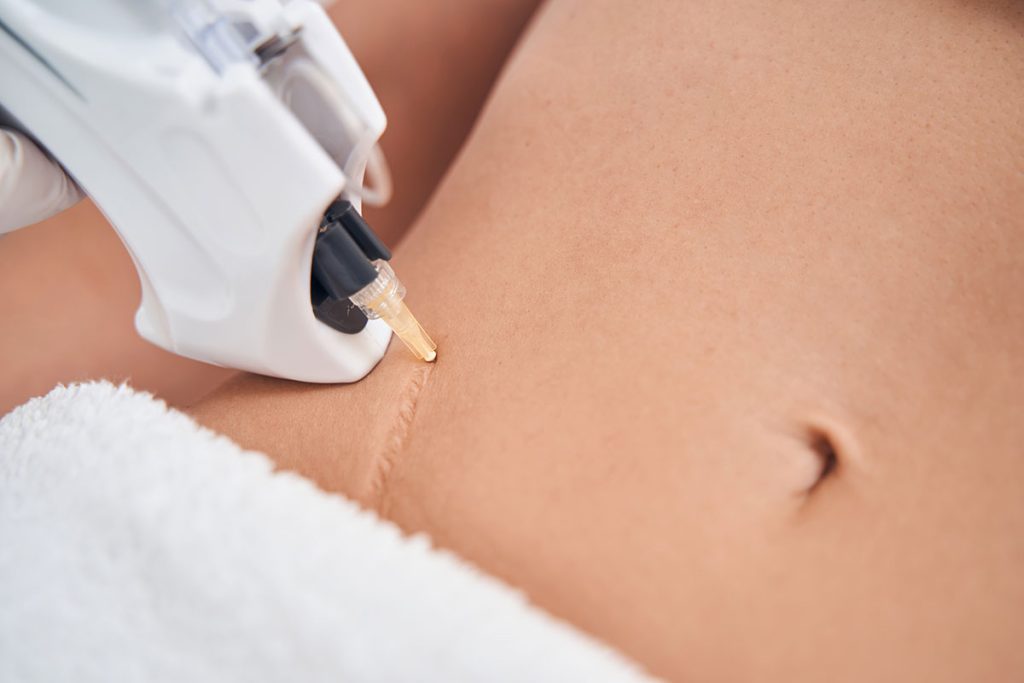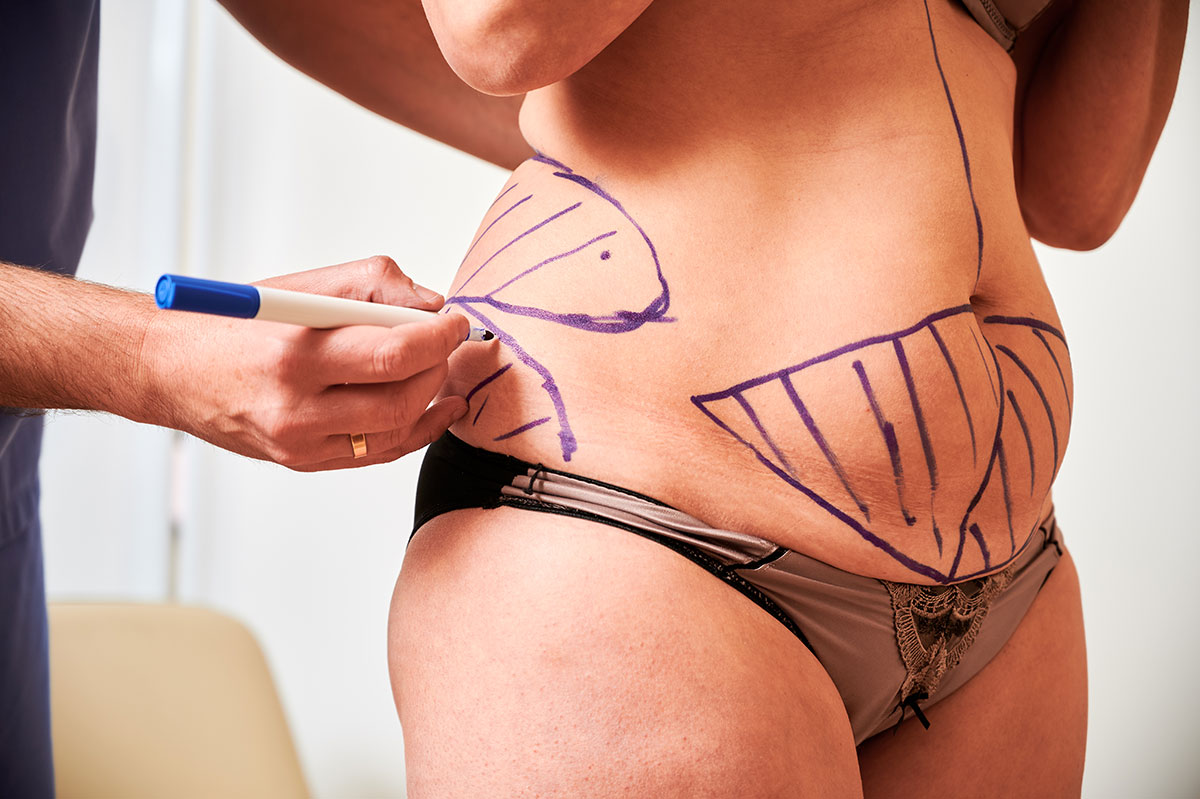For many who’ve undergone liposuction, the worry of scars can tarnish the joy of their new body contours. Though these marks are typically small, they still matter to those who have them.
This blog will explore various treatments that can minimize and even erase pesky liposuction scars, restoring your skin’s smooth appearance. Keep reading for solutions that bring confidence back to your skin!
Understanding Liposuction Scars
When considering liposuction, it’s essential to recognize that, like all surgeries, it may result in some scarring; understanding the characteristics and contributing factors of these scars can help set realistic expectations for post-procedure results.
Appearance of Liposuction Scars
Liposuction scars typically appear as small, discreet marks where the cannulas entered during the procedure. Over time, these tiny incisions usually become less noticeable and may even vanish completely as your skin heals.
The visibility of these scars after a liposuction procedure largely depends on the surgeon’s expertise, your body’s unique response to healing, and the specific techniques used in the surgery.
Many clients from the Dallas – Fort Worth area find their liposuction scars are minimal and easily concealed beneath natural skin folds or clothing. Cosmetic surgeons in this region strive for precision with each incision made during fat removal procedures to ensure scarring is kept to a minimum.
Healing process plays a critical role too; following post-surgery care instructions can make a significant difference in how these scars mature over time.
Factors Affecting Liposuction Scarring
Everyone’s body reacts differently to cosmetic surgery, and liposuction procedures are no exception. The way your skin heals after this body contouring technique can lead to varying scar appearances.
- Skin Type and Color: Individuals with darker skin tones may be more prone to hyperpigmentation, where scars become darker than the surrounding skin. Alternatively, hypopigmentation can occur, causing scars to appear lighter.
- Your Body’s Healing Process: Some people naturally heal with thicker scar tissue. This could result in hypertrophic or keloid scars, which are raised and more pronounced.
- Size of Cannula Used: Larger liposuction cannulas often remove fat more aggressively but may lead to more noticeable scarring compared to techniques using smaller cannulas.
- Technique Employed: Tumescent liposuction, which uses local anesthesia and causes less bruising, may reduce the likelihood of severe scarring compared to other more invasive methods.
- Surgeon’s Skill Level: A plastic surgeon with extensive experience in minimally invasive surgical procedures might leave less noticeable scars due to precise incisions and effective suturing techniques.
- Placement of Incisions: Strategic placement of incisions in less visible areas by a skilled plastic surgeon helps in minimizing scar visibility once healed.
- Post-Surgical Care: Following a plastic surgeon’s guidelines on caring for incision sites can affect scarring. Use of silicone gel sheets, compression garments, and avoiding UV light exposure will aid in better scar healing.
- Nutrition and Lifestyle Choices: Maintaining a healthy diet rich in vitamins that help heal wounds and staying hydrated improves your overall skin health, potentially leading to less conspicuous scars.
- Extent of Liposuction: More extensive liposuction procedures may require larger or multiple incisions which could contribute to more significant scarring compared to minor fat removals.
Common Types of Liposuction Scars
Liposuction scars come in different forms and may vary according to the technique used and individual healing processes. Some people develop hypertrophic scars, which are raised, red, and may be uncomfortable.
These usually occur when the body produces too much collagen during the healing phase. In contrast, atrophic scars are shallow depressions in the skin that can happen if underlying tissue is lost.
Hyperpigmentation occurs when a scar appears darker than surrounding skin due to excess melanin production; it’s common among those with darker complexions. Meanwhile, hypopigmentation causes scars to look lighter than the person’s natural skin tone because there isn’t enough melanin.
Both conditions might make someone self-conscious but treatment options exist to improve their appearance. For most patients undergoing liposuction procedures like smartlipo or tumescent techniques, typical marks are small incision sites that heal into barely noticeable dots.
Plastic surgeons strive for minimal scarring by placing these meticulously and often recommend aftercare treatments to enhance skin recovery and reduce scar visibility.

Effective Liposuction Scar Treatments
Discover the transformative methods available to minimize and manage liposuction scars, empowering you with choices that can enhance the healing of your skin post-procedure. Explore state-of-the-art treatments designed for remarkable improvements in scar appearance, ensuring your journey to refined contours doesn’t end with unwanted markings.
Silicone Gel Sheets
Silicone gel sheets come highly recommended for those looking to smooth out liposuction scars. They work by flattening and fading the discoloration of both hyperpigmentation and hypopigmentation that can result from these cosmetic procedures.
After just one week post-op, you can start applying these sheets directly onto your scars, facilitating a non-invasive route to healing without resorting to additional surgeries.
These flexible sheets are not only simple to use but also integrate seamlessly with other treatments such as chemical peels or laser therapy for even more impressive results. Imagine combining silicone gel sheets with a gentle derma roller and Hyper-Heal Cream; this potent mix is effective even on scars that have already established themselves.
As you look into options beyond invasive plastic surgery in the Dallas – Fort Worth area, consider how silicone gel sheets might play a part in your recovery journey before moving on to explore the benefits of Chemical Peels & Microdermabrasion.
Chemical Peels & Microdermabrasion
Chemical peels and microdermabrasion offer a fresh start for skin roughened by liposuction scars. These treatments gently remove the top layers of your skin, revealing smoother and more even-toned skin beneath.
A dermatologist applies a chemical solution to peel away old, scarred tissue during a chemical peel. This process can lighten the appearance of scars significantly over time.
Microdermabrasion takes a different approach to renewing your complexion. It uses tiny exfoliating crystals that are sprayed on the skin to buff away dead cells and scar tissues. Both methods promote new cell growth which is key in reducing scarring and improving overall skin quality.
For optimal results, it’s crucial to follow up with good aftercare practices; this includes using sunscreen regularly to protect your healing skin from harmful UV rays.
Moving forward beyond surface-level solutions, we explore how tattoo artistry can camouflage those stubborn scars – enter the world of Scar Camouflage Tattoo.
Scar Camouflage Tattoo
Moving beyond the surface treatments like chemical peels and microdermabrasion, scar camouflage tattooing offers a more lasting solution to conceal liposuction scars. It involves a specialized technique of permanent ink that blends the scars with your natural skin tone.
We use precise color matching strategies to ensure that the pigmentation applied mirrors your surrounding skin, making scars much less visible.
Choosing scar camouflage tattooing means opting for an artful approach to healing. This non-invasive procedure does not just cover up the marks; it carefully integrates them into your unique skin landscape.
Depending on the scar, we spend hours meticulously applying pigment layer by layer, crafting an appearance that boosts confidence without any surgical interventions or prolonged downtime.
For those who have undergone liposuctions and are seeking a sophisticated way to enhance their body’s aesthetics post-surgery, this innovative method stands out as a transformative option.
Scar Removal Surgery
Scar removal surgery offers a powerful solution for those looking to minimize the appearance of liposuction scars. Surgeons in the Dallas – Fort Worth area specialize in procedures that carefully remove or improve scar tissue, which not only enhances the skin’s appearance but also prevents keloids from forming.
This type of surgical treatment is especially effective for hyperpigmentation and hypopigmentation—common issues people face after liposuction.
Opting for scar removal surgery means choosing a more invasive approach, yet it brings about more dramatic results compared to non-surgical options like silicone gel sheets or laser treatments.
Post-operative care is crucial; following your surgeon’s advice on wound care will greatly influence healing outcomes. Proper hydration, avoiding tanning, and maintaining a balanced diet all support recovery after undergoing such aesthetic surgery procedures.
Conclusion
In navigating the journey to smooth, scar-free skin after liposuction, remember that patience and persistence are key. Explore the range of treatments available such as silicone gel sheets or laser therapy tailored to your unique needs.
Stay diligent with aftercare and keep your body well-hydrated as it aids in healing. Discuss options with a skilled professional who can guide you towards achieving the best possible outcome for your skin. If you are interested in learning more about scar camouflage tattooing, please use the contact form or give us a call today.
Embrace these steps confidently knowing they can lead you to an enhanced appearance post-liposuction.
FAQs
1. What are some scar treatment options after liposuction?
After liposuction, you can try treatments like platelet-rich plasma therapy, dermal fillers, and scar camouflage tattooing to reduce the appearance of scars.
2. Can fat transfer procedures help with liposuction scars?
Yes, transferring fat from one area of your body to another can improve skin texture and may help minimize scarring.
3. Are there non-invasive options for treating scars from liposuction?
Certainly! Options such as scar camouflage tattooing and silicone gel sheets are non-invasive treatments that can aid in reducing hypertrophic scarring after surgery.
4. How does weight loss affect liposuction scars?
Losing weight after surgery might change how your scars look because as your body changes shape, so does the skin around your scars.
5. What should I avoid doing after my liposuction to ensure minimal scarring?
Keep away from strenuous exercise, extreme heat or cold exposure, and soaking in water for too long; these could all impact how your surgical wounds heal and form scars.
6. Do plastic surgeons offer solutions for difficult-to-treat liposuction scars?
Plastic surgeons often have advanced techniques up their sleeves for complex cases like reconstructive surgery which might be beneficial if standard scar treatments don’t work.


